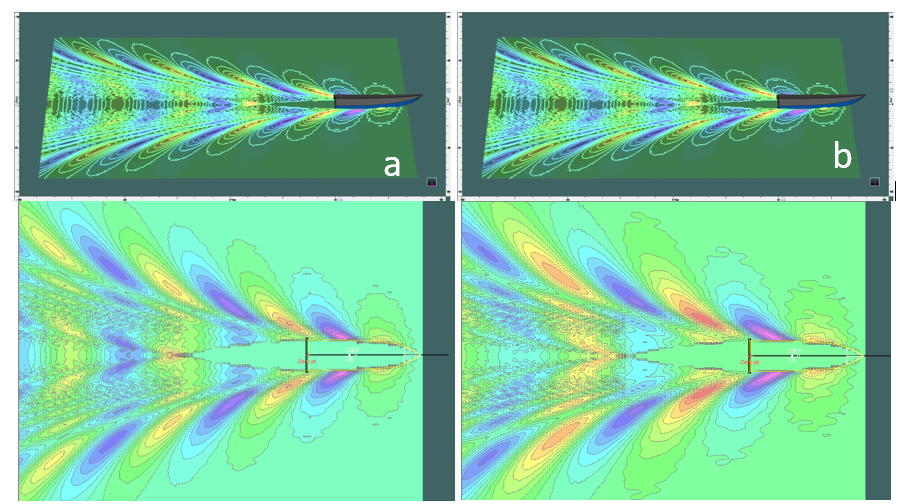Electric Boat Prototype: Effect of Propeller Size on Resistance and Power in Maxsurf Resistance Software
Main Article Content
Abstract
The boat model as a prototype of an electric boat has been successfully modeled and simulated using Maxsurf software. The research aims to determine the resistance and power values of the boat when operating using the Holtrop method. The Pakura boat was modeled using a Maxsurf modeler and simulated using Maxsurf resistance. Based on the modeling results, it shows that the boat model corresponds to the main dimensions in real conditions. The Pakura boat model has a displacement of 320.5 kg, amidship and immersed draft of 0.25 m, and a wetted area of 2.94 m2. The resistance and power are calculated using the resistance and power holotrop methods. Based on the simulation results, we obtained a prototype model of an electric boat that can operate on a certain propeller size. The maximum speed of the electric boat prototype with a 7-inch propeller is 4.31 kn. At 1500 rpm, the boat receives an HR of 92.71 N and requires a power of 205.57 W. On an 8-inch propeller that is 4.82 kN. At 1500 rpm, the boat receives an HR of 121.83 N and requires a power of 302.08 W. The size of the propeller affects the resistance value and power of the boat. The resistance value of the boat and operating power requirements increase along with changes in rpm on the electric engine. This can be used as a reference in determining the propulsion components for an electric boat prototype.
Downloads
Article Details

This work is licensed under a Creative Commons Attribution 4.0 International License.
Allow anyone to modify, improve, and make derivative works, even for commercial purposes, as long as they credit to you for the original work.
References
J. D. Forero and G. V. Ochoa, “Study of the Piston Secondary Movement on the Tribological Performance of a Single Cylinder Low-Displacement Diesel Engine,” Lubricants, vol. 8, no. 97, pp. 1–32, 2020.
S. S. Tumigolung, F. P. T. Pangalila, and F. E. Kaparang, “Studi tentang Pengaruh Perbedaan Daya Mesin terhadap Kecepatan dan Konsumsi Bahan Bakar Minyak pada Perahu Pakura,” J. Ilmu dan Teknol. Perikanan. Tangkap, vol. 2, no. 5, pp. 187–193, 2017.
A. Boretti, “Advantages and Disadvantages of Diesel Single and Dual-Fuel Engines,” Frontiers Mech. Eng., vol. 5, no. 12, pp. 1–15, 2019.
M. Mehedi and T. Iqbal, “Optimal Sizing of a Hybrid Power System for Driving a Passenger Boat in Bangladesh,” Conf. Pap., vol. 2, no. 3, pp. 1–6, 2020.
B. H. Li, Z. Wang, L. Chen, and X. Huang, “Research on Advanced Materials for Li-ion Batteries,” Adv. Mater., pp. 4593–4607, 2009.
A. Umeda, E. Shimizu, and T. Oode, “Design Strategy of Battery Powered Boat and its Evaluation,” in Proceedings of the Twenty-fifth (2015) International Ocean and Polar Engineering Conference, 2015, no. Juni, pp. 911–917.
E. Giraldo-pérez, E. Betancur, and G. Osorio-gómez, “Experimental and statistical analysis of the hydrodynamic performance of planing boats : A Comparative Study,” Ocean Eng., vol. 262, no. July, p. 112227, 2022.
Y. Budiman, F. Romansyah, M. N. Rochim, M. S. Akmal, M. Solikin, and A. Yudianto, “Perancangan bodi kapal patroli lepas pantai : analisis numerik hidrodinamika bodi deep v-hull , bulbous hull , dan catamaran melalui simulasi software maxsurf,” Semin. Nas. Ilmu Tek. dan Apl. Ind., vol. 5, no. 2, pp. 122–127, 2022.
A. R. Prabowo, R. A. Febrianto, and T. Tuswan, “Performance evaluation on the designed v-shaped monohull ship models,” J. Appl. Engeineering Sci., vol. 20, no. 2, pp. 610–624, 2022.
R. N. Situmorang, P. Manik, and A. Wi. B. Santosa, “Analisa Nilai Thrust Optimum Propeller Pada Kapal Tugboat Pelabuhan Paket-II 2x1850HP Dengan Variasi Diameter Propeller, Jumlah Daun Propeller & Kecepatan Putaran Propeller(RPM),” J. Tek. Perkapalan, vol. 8, no. 3, pp. 112–116, 2020.
I. N. Aini, H. Boesono, and I. Setiyanto, “Uji Kecepatan Perahu Sopek Dengan Menggunakan Propeller Dua Daun dan Tiga Daun di Perairan Tambak Lorok Semarang,” J. Fish. Resour. Util. Manag. Technol., vol. 4, no. 4, pp. 39–49, 2015.
F. Laamena and A. Taihutu, “Kajian Optimasi Ukuran Kapal Tradisonal dan Perhitungan Hambatannya,” J. Metiks, vol. 1, no. 1, pp. 17–22, 2021.
R. A. Anugrah and M. P. A. Fath, “Simulasi Numerik Kapal Katamaran Pendeteksi Kedalaman Banjir Menggunakan Software Maxsurf untuk Mencari Resistance,” Quantum Tek., vol. 3, no. 2, pp. 65–70, 2022.

